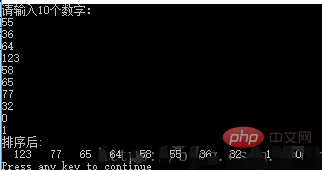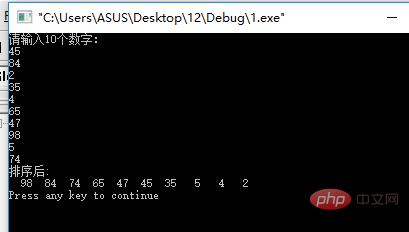 Backend Development
Backend Development
 C#.Net Tutorial
C#.Net Tutorial
 Learn how to use selection sort and bubble sort in three minutes
Learn how to use selection sort and bubble sort in three minutes
Learn how to use selection sort and bubble sort in three minutes

Today I will share with you some algorithms about C language, Selection sort and bubble sort.
For selection sorting, first understand the idea of sorting. Given an array, this idea first assumes that the first element of the array is the largest or smallest. At this time, three variables will be used to represent the subscripts of the elements.
One represents the current one, one represents the largest or smallest subscript found, and one is used to store the subscript of the maximum value in each cycle. After mastering the basic idea of the program, proceed with sequencing. After finding the largest subscript, assign it to the largest subscript except each time.
After finding it, determine whether the assumed current value is the maximum value of this cycle. If not, exchange the maximum and current values, thereby arranging the array in a certain order, and finally write a loop to output the result. .
The code is not difficult, so I will explain it step by step. I just attach the code. If you don’t understand, you can leave me a message and I will explain it to you. Or if there is anything wrong, I can correct it.
#include<stdio.h>
void main()//主函数
{
int a[10];
int i,j,w;
printf("请输入10个数字: \n");
for(i=0;i<10;i++)
scanf("%d",&a[i]);
for(i=0;i<10;i++)
{
for(j=0;j<10;j++)
if(a[i]<a[j])//进行比较
//比较后进行交换
{
w=a[i];
a[i]=a[j];
a[j]=w;
}
}
printf("排序后:\n");
for(i=0;i<10;i++)
printf("%4d",a[i]);
printf("\n");
}Result display:

Next is Bubble sort, this is the most popular in C language One of the most commonly used algorithms, because it is easier to understand, it is the first thing most people use when they want to sort. This algorithm is relatively easy to understand.
For bubble sorting, the main idea is to compare adjacent numbers in pairs. If the latter one is larger or smaller than the previous one, swap its positions until all numbers are compared.
If an array of size n is given, n-1 comparisons are required, and each comparison is n-1-i times. i represents the subscript that has been compared in the last loop. Write two loop judgments. If exchange is needed, exchange it. If exchange is not required, compare the next two numbers until all numbers are compared.
Finally, use a loop to output all the sorted numbers. The code is as follows:
#include<stdio.h>
#define N 10
void main()
{
int a[10];
int i,j,t;
printf("请输入10个数字: \n");
for(i=0;i<10;i++)
scanf("%d",&a[i]);
//使用两层循环
for(i=0;i<N-1;i++)
{
for(j=i+1;j<N-(i+1);j++)
if(a[j]<a[j+1])//比较大小
{
t=a[j];
a[j]=a[j+1];
a[j+1]=t;
}
}
printf("排序后:\n");
for(i=0;i<10;i++)
printf("%4d",a[i]);
printf("\n");
}Result:

##Conclusion:
For selection The analysis of sorting is very simple. The size of the input is determined by the array elements. The basic operation is the key value comparison A[j]Therefore, for any input, selection sort is an O(n^2) algorithm. Therefore, the time complexity of this experiment is O(100) and the space complexity is O(10). However, the number of times the keys are exchanged is only O(n), or to be more precise, n-1 times (one exchange is performed for each iteration of the i loop). This feature makes selection sort superior to many other sorting algorithms. Bubble sorting is a process in which two adjacent numbers are compared, and the larger number sinks to the bottom (or the smaller number floats up). A total of n-1 comparisons and exchanges are performed. In order to facilitate the implementation of the above bubble algorithm, consider using only a one-dimensional array to store 10 integer data. During the sorting process, the data is always in this array (operated in place and does not occupy additional space). Therefore, the time complexity of this algorithm is O(n-1) and the space complexity is O(1). Thank you everyone for reading, I hope you will benefit a lot. This article is reproduced from: https://blog.csdn.net/zjy18886018024/article/details/80718713 Recommended tutorial: "C Language"
The above is the detailed content of Learn how to use selection sort and bubble sort in three minutes. For more information, please follow other related articles on the PHP Chinese website!

Hot AI Tools

Undresser.AI Undress
AI-powered app for creating realistic nude photos

AI Clothes Remover
Online AI tool for removing clothes from photos.

Undress AI Tool
Undress images for free

Clothoff.io
AI clothes remover

Video Face Swap
Swap faces in any video effortlessly with our completely free AI face swap tool!

Hot Article

Hot Tools

Notepad++7.3.1
Easy-to-use and free code editor

SublimeText3 Chinese version
Chinese version, very easy to use

Zend Studio 13.0.1
Powerful PHP integrated development environment

Dreamweaver CS6
Visual web development tools

SublimeText3 Mac version
God-level code editing software (SublimeText3)

Hot Topics
 1664
1664
 14
14
 1423
1423
 52
52
 1318
1318
 25
25
 1269
1269
 29
29
 1248
1248
 24
24
 C language data structure: data representation and operation of trees and graphs
Apr 04, 2025 am 11:18 AM
C language data structure: data representation and operation of trees and graphs
Apr 04, 2025 am 11:18 AM
C language data structure: The data representation of the tree and graph is a hierarchical data structure consisting of nodes. Each node contains a data element and a pointer to its child nodes. The binary tree is a special type of tree. Each node has at most two child nodes. The data represents structTreeNode{intdata;structTreeNode*left;structTreeNode*right;}; Operation creates a tree traversal tree (predecision, in-order, and later order) search tree insertion node deletes node graph is a collection of data structures, where elements are vertices, and they can be connected together through edges with right or unrighted data representing neighbors.
 The truth behind the C language file operation problem
Apr 04, 2025 am 11:24 AM
The truth behind the C language file operation problem
Apr 04, 2025 am 11:24 AM
The truth about file operation problems: file opening failed: insufficient permissions, wrong paths, and file occupied. Data writing failed: the buffer is full, the file is not writable, and the disk space is insufficient. Other FAQs: slow file traversal, incorrect text file encoding, and binary file reading errors.
 How debian readdir integrates with other tools
Apr 13, 2025 am 09:42 AM
How debian readdir integrates with other tools
Apr 13, 2025 am 09:42 AM
The readdir function in the Debian system is a system call used to read directory contents and is often used in C programming. This article will explain how to integrate readdir with other tools to enhance its functionality. Method 1: Combining C language program and pipeline First, write a C program to call the readdir function and output the result: #include#include#include#includeintmain(intargc,char*argv[]){DIR*dir;structdirent*entry;if(argc!=2){
 CS-Week 3
Apr 04, 2025 am 06:06 AM
CS-Week 3
Apr 04, 2025 am 06:06 AM
Algorithms are the set of instructions to solve problems, and their execution speed and memory usage vary. In programming, many algorithms are based on data search and sorting. This article will introduce several data retrieval and sorting algorithms. Linear search assumes that there is an array [20,500,10,5,100,1,50] and needs to find the number 50. The linear search algorithm checks each element in the array one by one until the target value is found or the complete array is traversed. The algorithm flowchart is as follows: The pseudo-code for linear search is as follows: Check each element: If the target value is found: Return true Return false C language implementation: #include#includeintmain(void){i
 How to output a countdown in C language
Apr 04, 2025 am 08:54 AM
How to output a countdown in C language
Apr 04, 2025 am 08:54 AM
How to output a countdown in C? Answer: Use loop statements. Steps: 1. Define the variable n and store the countdown number to output; 2. Use the while loop to continuously print n until n is less than 1; 3. In the loop body, print out the value of n; 4. At the end of the loop, subtract n by 1 to output the next smaller reciprocal.
 C language multithreaded programming: a beginner's guide and troubleshooting
Apr 04, 2025 am 10:15 AM
C language multithreaded programming: a beginner's guide and troubleshooting
Apr 04, 2025 am 10:15 AM
C language multithreading programming guide: Creating threads: Use the pthread_create() function to specify thread ID, properties, and thread functions. Thread synchronization: Prevent data competition through mutexes, semaphores, and conditional variables. Practical case: Use multi-threading to calculate the Fibonacci number, assign tasks to multiple threads and synchronize the results. Troubleshooting: Solve problems such as program crashes, thread stop responses, and performance bottlenecks.
 How to define the call declaration format of c language function
Apr 04, 2025 am 06:03 AM
How to define the call declaration format of c language function
Apr 04, 2025 am 06:03 AM
C language functions include definitions, calls and declarations. Function definition specifies function name, parameters and return type, function body implements functions; function calls execute functions and provide parameters; function declarations inform the compiler of function type. Value pass is used for parameter pass, pay attention to the return type, maintain a consistent code style, and handle errors in functions. Mastering this knowledge can help write elegant, robust C code.
 Integers in C: a little history
Apr 04, 2025 am 06:09 AM
Integers in C: a little history
Apr 04, 2025 am 06:09 AM
Integers are the most basic data type in programming and can be regarded as the cornerstone of programming. The job of a programmer is to give these numbers meanings. No matter how complex the software is, it ultimately comes down to integer operations, because the processor only understands integers. To represent negative numbers, we introduced two's complement; to represent decimal numbers, we created scientific notation, so there are floating-point numbers. But in the final analysis, everything is still inseparable from 0 and 1. A brief history of integers In C, int is almost the default type. Although the compiler may issue a warning, in many cases you can still write code like this: main(void){return0;} From a technical point of view, this is equivalent to the following code: intmain(void){return0;}



